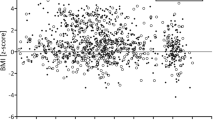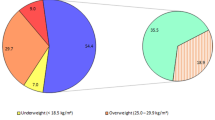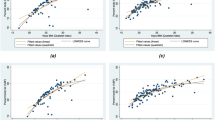Abstract
Objective: To test the hypothesis that ‘normal but vulnerable’ adults, as defined by body mass index (BMI) in combination with mid-upper-arm-circumference (MUAC), are closer to normal than to malnourished ones. For that purpose body composition measurements were compared between normal and low BMI categories and according to MUAC value in an African context and for different age groups.
Design: Reanalysis of data from a previous cross-sectional cluster sample nutrition survey.
Setting: A rural area of the Republic of Congo, Central Africa.
Subjects: A representative sample (n=544) of non-pregnant women.
Main outcome measures: Arm muscle area was calculated from measurements of triceps skinfold thickness and MUAC. Peripheral body fat was assessed by the sum of four skinfold thicknesses. The ratio of resistance at high and low frequencies was derived from whole body measurement of multifrequency bioelectrical impedance analysis and used as the extracellular to total body water ratio index.
Results: The prevalence of thinness decreased from 18.7% as defined by BMI alone to 9.0% as defined by BMI and MUAC. This difference was due to the group of subjects classified as ‘normal but vulnerable’ (9.7%). Prevalence of thinness increased with age when assessed by BMI alone, but no longer when assessed by BMI and MUAC. Comparison with the BMI≥18.5 kg/m2 category showed that in ‘normal but vulnerable’ subjects lower BMI was accompanied by lower both fat and lean compartments, in absolute values, but the equilibrium of body water compartments was not altered. In BMI<18.5 women, low MUAC was associated with altered lean tissues, at peripheral and whole body level, whereas fat tissue did not differ.
Conclusions: ‘Normal but vulnerable’ subjects appeared as ‘thin but healthy’ rather than malnourished, at all ages, even though their BMI was lower than 18.5 kg/m2. The new classification of thinness based on BMI and MUAC provides a more specific index of nutritional status when restricting the thin category to more at-risk subjects.
European Journal of Clinical Nutrition (2001) 55, 393–399
This is a preview of subscription content, access via your institution
Access options
Subscribe to this journal
Receive 12 print issues and online access
$259.00 per year
only $21.58 per issue
Buy this article
- Purchase on Springer Link
- Instant access to full article PDF
Prices may be subject to local taxes which are calculated during checkout
Similar content being viewed by others
Author information
Authors and Affiliations
Contributions
Guarantors: A Gartner and B Maire.
Contributors: BM and FD initiated the study; AG was in charge of the study and was involved in the fieldwork; YK supervised and was involved in data collection in the field; PT and AG were responsible for data management and analysis; all authors participated to the elaboration of the research protocol and to the redaction of the manuscript.
Corresponding author
Rights and permissions
About this article
Cite this article
Gartner, A., Maire, B., Kameli, Y. et al. Body composition unaltered for African women classified as ‘normal but vulnerable’ by body mass index and mid-upper-arm-circumference criteria. Eur J Clin Nutr 55, 393–399 (2001). https://doi.org/10.1038/sj.ejcn.1601171
Received:
Revised:
Accepted:
Published:
Issue Date:
DOI: https://doi.org/10.1038/sj.ejcn.1601171



